All about indoor violets
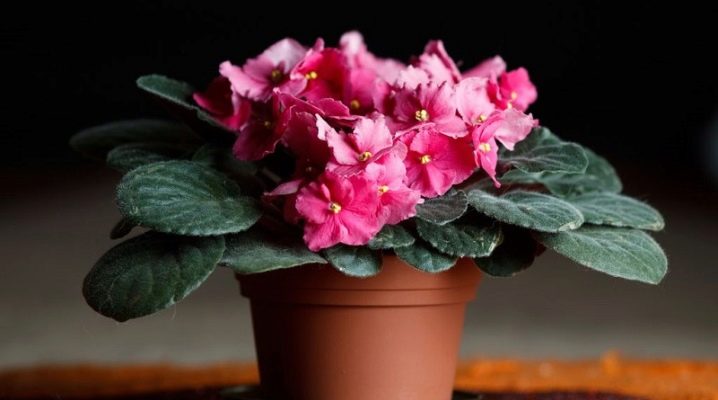
Houseplants are very diverse. But still, recognized leaders in popularity are found among them. A striking example of this is the so-called indoor violet.

History
There is one interesting moment in the history of this species. As you know, violets are first mentioned in the myths of the ancient period. But the problem is that the plant from ancient Greek mythology and what is now mainly called violets are two different biological species. Violets (Saintpaulias) were discovered in the mountains of eastern Africa at the end of the 19th century. They were found by the commandant of the German colony Walter von Saint-Paul (the culture is named after him).
The scientific description of the plant and the first receipt of flowering seedlings are the merit of botanist Hermann Wendland. Saintpaulia was introduced into mass circulation surprisingly quickly. They found her in 1892, and already in 1893 she appears at the exhibition and immediately fascinated flower growers. Nothing strange: the representative of the Gesneriaceae family, called the Usambar violet, looks very beautiful. The definition "uzambara" is associated with the name of the mountain range, near which the wild-growing Saintpaulia was first discovered.
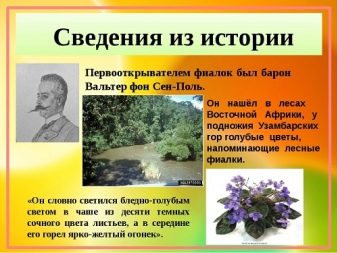
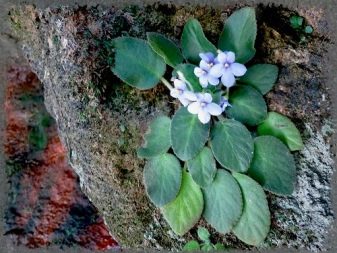
The word "violet" appeared because of the obvious similarity with real violets (which were quickly relegated to the background). In 1893, the glory of Saintpaulia already thunders all over Europe, and in 1894 American flower growers also met her. Very soon, it was in the New World that a key breeding center for modern violets was formed. The next significant date for the Uzambar violets is 1898. It was then that breeders were able to breed plants with pink, white and burgundy flowers.
In the 1920s, one of the Californian firms managed to move from the cultivation of Saintpaulia seeds to leaf propagation. This immediately simplified the work and made it much more productive. In a matter of years, it has been possible to replenish the assortment with more than ten promising varieties. As a result, a real "violet boom" begins. A number of clubs for the cultivation of this flower are being created.
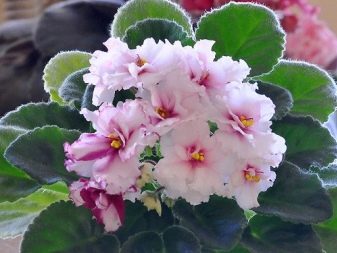
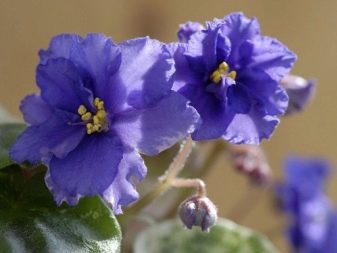
In 1938, backlight technology becomes public. Its competent application has made it possible to grow plants with a previously unattainable flower size in a temperate climate. Many varieties that are still popular were created from 1940 to 1970. It was then that the world became acquainted with the ruffled and fringed petals, with a star-shaped flower. New properties and possibilities of the violet were constantly revealed (as we will now call it uniformly, starting from the universal practice).

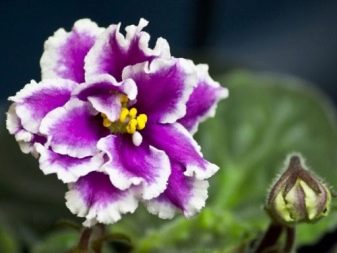
Description
Growing violets at home turns out to be a very popular business and even the capriciousness of this culture, the need for scrupulous care for it, do not interfere with such success. Among the Saintpaulias, there are dozens of varieties and many varieties. It is not difficult to select a plant that is suitable in shape and color. Its highest height reaches 0.3 m. The perennial has a short stem, on which large oval leaves develop. Depending on the specific variety, they are:
- elongated in length;
- heart-shaped;
- with a jagged perimeter;
- with a smooth perimeter;
- light green color;
- dark green color.
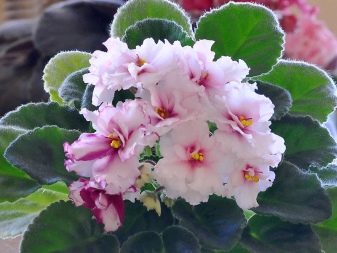
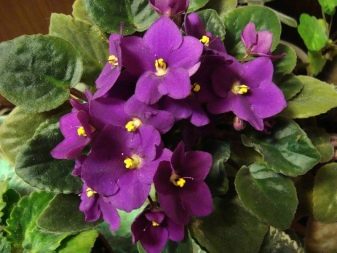
But some representatives of the family of uzambara violets can have foliage of a complex color. We are talking about a combination of a base covered with white spots with a white border (and all this is on a dark green background).Flowers in violets are of the fringed, double or simple types. The petals are characterized by a wavy or corrugated structure. The diameter of the flower ranges from 2 to 4 cm. On the violet, they gather in group inflorescences. Coloring varies greatly, there are both monochrome and intertwined specimens. May be present:
- borders in contrasting tones;
- stripes;
- various points;
- small and large spots.
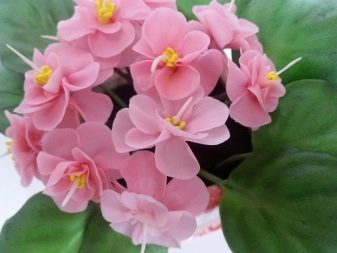
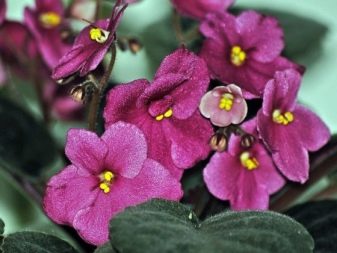
The African violet does not smell in nature. But breeding hybrids sometimes have a very attractive aroma. Since the plant comes from hot countries, it really needs lighting and requires moderate humidity. But the cold periods, indoor violets are not going through well. At the same time, you can not put the flower in direct sunlight.
The lion's share of complaints that the plant on the windowsill looks somehow not as promised in the articles and shown in the photographs is connected precisely with a violation of the growing rules. Direct sunlight causes immediate burns. If it is impossible to remove a decorative flower in the shade, it is done artificially - using curtains, blinds, parchment. It is categorically unacceptable to expose a delicate culture to drafts.
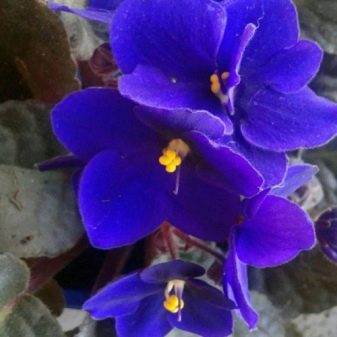
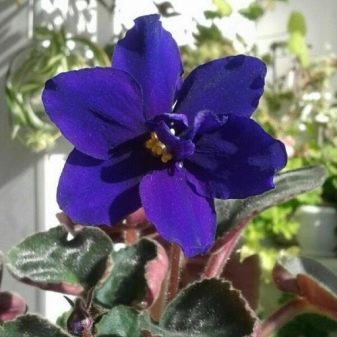
The contradictory properties of the violet are due to its origin. Although it grows in Africa, it concentrates around waterfalls and streams flowing in the mountains. Such areas of tropical rainforest are characterized by a rather mild climate. Therefore, it is this type of plant that can be easily cultivated in Russian conditions. Saintpaulia shrubs in their natural habitat are classified as evergreens. But in the northern countries, it can bloom a little less, only a few varieties are covered with flowers all year round.
The thin roots of the bushes occupy the upper soil layer. The ideal conditions for them are created on plateaus and on rocky terraces. The fleshy shoots are short. The underside of the leaves is usually pink or burgundy. Both the petioles and the violet leaves themselves are covered with an abundant layer of villi. Due to the pronounced relief, it is not difficult to examine the veins.
In the middle of the leaf rosettes, inflorescences are formed, resembling brushes. They are formed by several flowers, rounded in shape. There are 5 petals of a simple or double type per bud. When the flowers bloom, their diameter is from 3 to 8 cm.The tonality can vary greatly, the fruits look like boxes outwardly, they contain a lot of small, elongated seeds
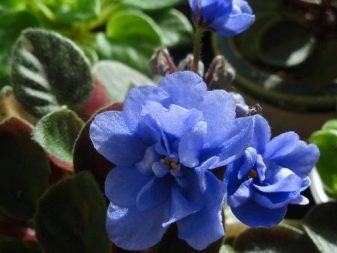
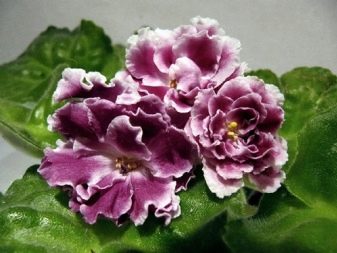
Classification
By outlet size
In total, more than 32,000 varieties of the Usambara violet are distinguished. So we can confidently say that the breeders did not work in vain. The smallest flowers do not even reach 2 cm, violets with petals up to 4.5 cm fall into the middle group.The largest petals can reach 10 cm. But besides the actual size, it must be borne in mind that the perception of flowers directly depends on:
- the ratio of their size to the size of the foliage;
- the number of buds forming;
- air humidity;
- air temperature.
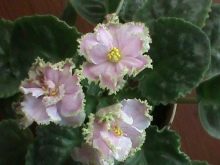
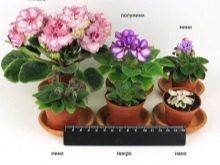
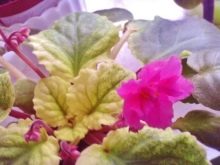
By flower shape
The outwardly simplest type of violet flower was named "Anyutka". This is a 5-petal bud. Most often, there are 2 relatively small petals on top compared to the lower petals. The so-called "bells" are a little more complicated. This word alone is enough to understand exactly how they look. The so-called "star" (5 petals, almost the same size) is considered a very attractive type.
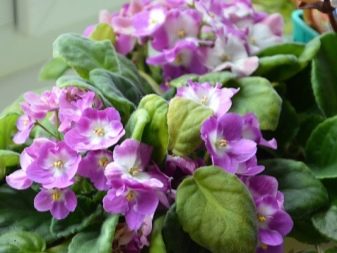
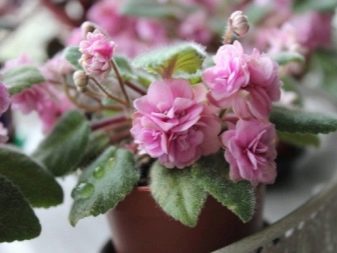
By color of petals
It is customary to call flowers "chimeras" in which the middle and edge of the petal are connected by peculiar stripes. Outwardly, they look like the spokes in a bicycle wheel. The word "Fantasy" denotes flowers covered with areas of contrasting or darker tones than the main background. These plots might look like:
- spray;
- strips;
- glimpses.
Some flowers have rimmed petals.It varies significantly depending on the variety. The multicolored varieties of violets are highly prized. But those that are painted in 2 or more shades of the same paint also look attractive.
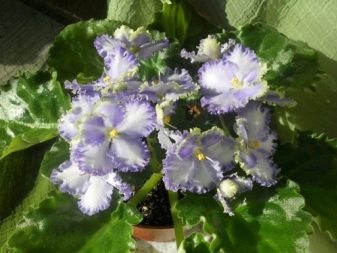
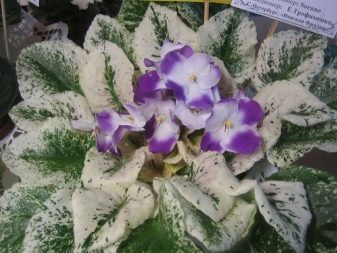
By the number of petals
Terry is usually called those Saintpaulias, which have 2 or more rows of petals. Semi-double flowers have 6 or more simple petals. In this case, there may be a kind of scallop (sometimes a bow) in the middle. However, the second row cannot be 100% full. Of course, semi-double varieties will be slightly smaller.
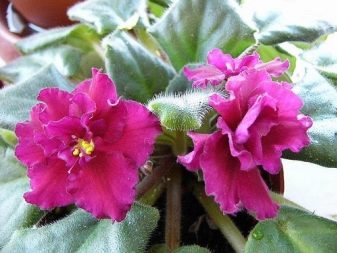
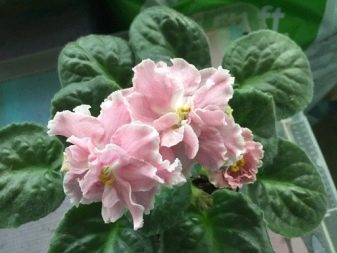
By type of leaves
If the foliage has a simple texture and uniform shape, it is classified as a flat (otherwise they say simple) type. The "Girl" view has deep scallops. Most often, these scallops resemble a circle or a heart. In the heart, where the base of the leaves is located, there is a white or yellow mark. Pointed leaves are called leaves, the edges of which converge in strictly defined places.
Violets can also have quilted leaves. They are characterized by uplifts in the gaps between the veins. If the outer edges of the foliage look carved or uneven, they are referred to as lace format. Variegated violets are a very attractive solution in many cases. Their peculiarity is the presence of inclusions (cream, white, pink or light yellow).


By color of leaves
It is customary to divide variegated violets into several types. If the variegated areas are gathered at the edges, then this is the "Tomi Lu" format. When the leaves are variegated only inside the crown, and around the perimeter they are more uniform, it is customary to talk about the crown type of variegation. There is also mosaic diversity. As you might guess, these are multi-colored areas scattered more or less uniformly over the entire surface.


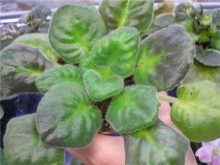
The best varieties and their characteristics
The wide variety of the appearance of violets is due precisely to the fact that a lot of different varieties have been bred. All types of African flowers could only be described in a voluminous book. Therefore, it is advisable to focus only on the optimal varieties. The Frosty Cherry deservedly won wide popularity. It forms double-type flowers, scarlet with cherry tint.
A white fringe is found on "Frosty Cherry". Such a culture can decorate a window sill, a flower bed, and a garden. As the flowers develop, they become darker and darker. However, the lack of light leads to their lightening. This variety is one of the thermophilic, moreover, it does not tolerate excessive heat and excessive humidity.
Another cultivar "Ice Rose", contrary to its name, is not at all prickly. On the contrary, this variety is considered one of the most beautiful violets. The elegance is achieved through a unique combination of white, light green and cherry colors. Ruffled fringe becomes a very bright and expressive decoration. The flower looks as luxurious as possible.
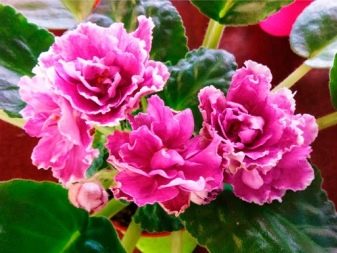
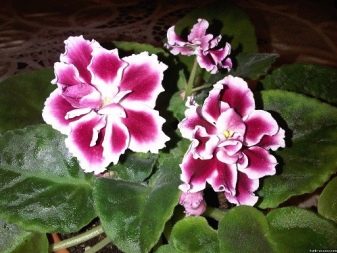
Those who want to get attractive double flowers and an attractive scent at the same time should choose "Posh Poppy". Light crimson buds and other components give the impression of a ruffled dress. It seems to be swaying in the wind. The originality of the plant is also added by the unique color of the foliage (it is difficult to find another variety where there would be a smooth transition between light green and dark emerald colors). It is possible to grow the "Posh Poppy" in any garden - and everywhere it becomes a real decoration.
If you ask experienced flower growers which violets are the most surprising with their colors, then all or almost all will name Isadora... The semi-velvet pinkish flowers, distinguished by their splendor, are covered with spots of a lilac shade. There are also rim ruffles. Even not too sophisticated gardeners will be delighted with such plants. Although Isadora is somewhat similar to peonies, she is even more beautiful than them.
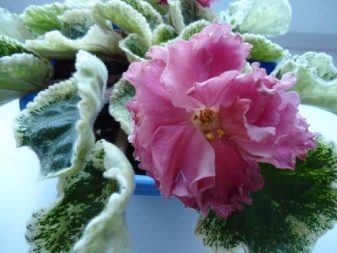
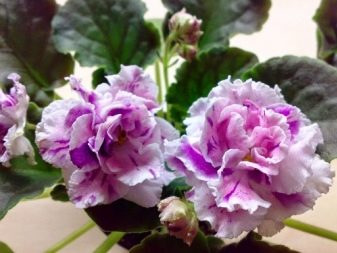
An extremely original choice - the so-called "Lituanica"... Suffice it to say that this violet does not at all resemble the usual appearance of a violet.
By the type of inflorescences, it is easy to confuse it with:
- rosehip;
- dahlias;
- tea rose.
In terms of sophistication, it is difficult to name violets equal to the variety "Rosemary"... Delicate petals of semi-velvet color look more attractive thanks to patterns of purple color. Thanks to the wavy edges, something like a coral reef appears. The splendor and brightness of the buds makes the plant even more beautiful. During the flowering season, Rosemary throws out 5 or 6 flowers.
Important! Plants of this variety require limited watering. Excessive irrigation is contraindicated for them. To improve flowering, you need to take care of decent lighting. The variety may also be attractive. "Magenta"... Dark burgundy petals surrounded by dark green foliage look simply incomparable.
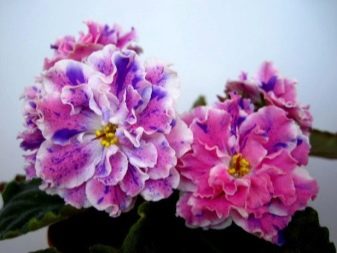
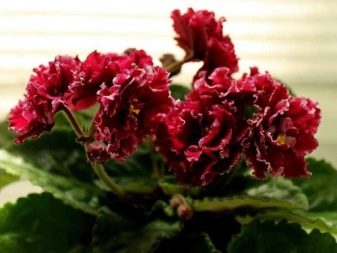
A kind of "chameleon" in the world of violets - a variety "Gray Ocean"... From flowering to flowering, it turns from white to more and more blue. At the very end, a completely different variety of violets is obtained - "Black Pearl". Another noteworthy violet - "Chimera"... She was not bred deliberately, the flower turned out due to random hybridization.
Among violets blooming as long as possible, stands out "Darling"... Delicate, maximally airy flowers are mainly painted in light pink tones. However, sometimes they also come in a milky peach color. The small amount of individual colors is offset by a significant amount. By placing the plant in a relatively cool place, you can shift the color balance towards white.
"Darling" is not characterized by high care requirements. It is necessary to provide only warmth and moderate moisture. A "The land of crimson clouds" differs in greater originality, which is quite consistent with the name. Warm crimson flowers have a yellow core. And around all this splendor, dark green foliage grows.
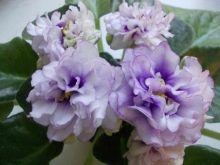

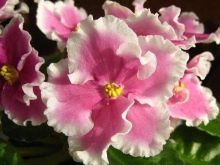
How to choose?
The correct choice of violets cannot be limited to the most popular and attractive varieties. It is advisable to consider first of all the simplest unpretentious varieties. The fact is that the violet is very capricious, it is extremely difficult for even experienced flower growers to cope with it. It is quite difficult to achieve an excellent result, which exhibitors and organizers are proud of. You can buy planting material in any season.
If it's hot outside, you can be afraid of decay of seedlings and seedlings. If you buy a baby at this time, she will get sick for a long time. In winter, plants on the way home may freeze completely. It is best to buy leafy cuttings from exhibitions.
It makes no sense to take the leaves from below: in most cases, they have already developed the potential for rooting and development.
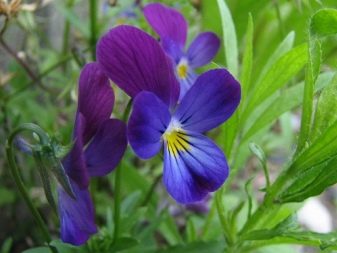
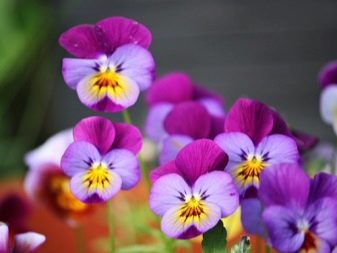
A leaf taken from the center of the outlet does not fit well. There they are too young and not sufficiently resistant to adverse conditions. When buying a finished plant, you should immediately check for brown areas on the foliage. It's too bad when they are too soft. Vendors may argue that foliage will become firm again after watering, but this is not always the case.
It is worth touching the violet rosette. If it falls apart when touched, such planting material should not be taken under any circumstances. It is recommended to carefully check that the selected variety is zoned in your region (city).
You cannot acquire as many varieties as possible at the same time, hoping to "experiment" - this will definitely not lead to anything good.
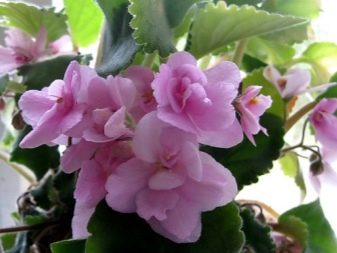
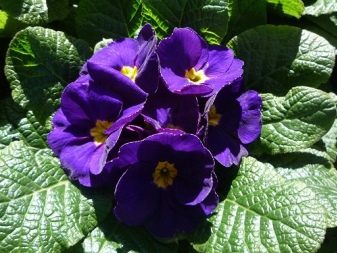
How to grow?
Temperature regime
It is appropriate to start a conversation about caring for violets at home with the definition of a suitable thermal regime. If it is chosen incorrectly, a number of unpleasant consequences can occur. On the other hand, skillfully manipulating the temperature can slow down or speed up development. Plants from Africa categorically do not like temperatures of 16 degrees or less. In such conditions, all life processes are significantly inhibited.
At the same time, you can not be afraid of a drop in temperature by 8-10 degrees below the average annual minimum in East Africa. English gardeners successfully grow violets throughout the year using warm orchid greenhouses. The temperature is maintained there from 26 to 30 degrees. Anyone who tries this regime makes it much easier for the plant to bloom.
For room culture, it is required to maintain a temperature of 21 degrees during the daytime and 16 degrees after dark. Russian gardeners note that violets grow most actively at a daytime temperature of 25 and a nighttime temperature of 20 degrees. But you need to pay attention to the illumination. A forced increase in air warming up to 25 degrees will not cause harm if the period does not exceed 3 or 4 days. However, flowering at this time cannot occur in principle.
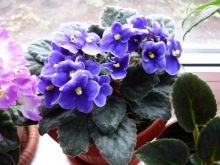

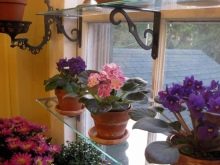
Top dressing
When the time for flowering comes, but for some reason it does not happen, you must definitely try to apply top dressing at the root. In the spring, it is required to add formulations based on nitrogen, phosphorus and potassium. Complex mixtures include phosphates and superphosphates, as well as potassium salts. Various formulations can be added separately or together. Complex selections of substances are more convenient when applied once a year under flowering shrubs.
If you don't want to use branded store-bought fertilizers, you can take care of the violets with the help of natural dressings. They can be done quite often, but it is imperative to follow the recommendations of breeders and suppliers of agricultural chemicals. It is necessary to check the state of the plantings by touching the stem and carefully examining it.
Important! Top dressing is not used in the autumn months. Otherwise, the violet will be unnecessarily tired, sometimes it does not survive the winter in this state.
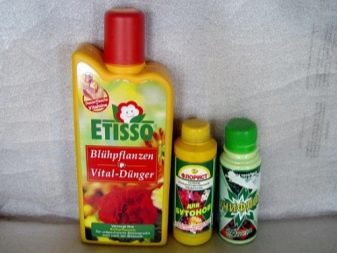
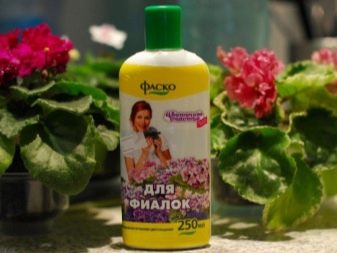
It is categorically impossible to make top dressing also:
- 30 days after transplanting;
- with excessive dryness of the earth;
- with excessive temperature or hypothermia;
- when direct sunlight hits the aboveground parts of the violets;
- during attacks of masses of pests (until they are dealt with, and the violet does not regain its strength).
It is preferable to use not solid, but liquid mixtures of nutritional components. They are poured into pallets. But an alternative way is also possible - careful root application.
At the same time, contact of fertilizers with leaves is categorically unacceptable, so that the former do not harm.
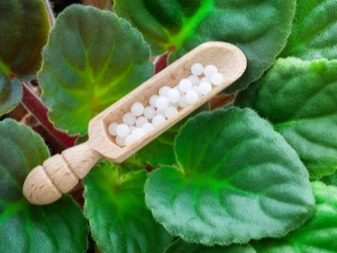
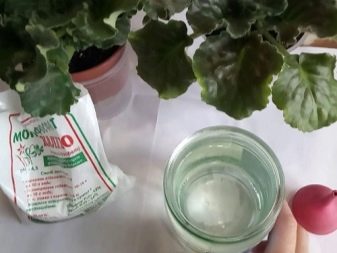
Particular attention should be paid to feeding the "children" of violets. It is permissible to introduce nutrients into the soil only after the formation of roots. There is nothing wrong with this: after all, in natural African conditions, this plant successfully develops on poor soil. Moreover, it is precisely this situation that is the key to success. But when the time comes for the formation of peduncles and buds, it is required to add phosphorus compounds (which ones are decided by their choice).
Replenishment with black tea can give quite good results. It is enough to use a simple drunk tea. You just need to scatter it over the surface and level it. But there is another way - brewing medium-strength black tea. In both cases, the addition of the required components should be made after 15 days.
Coffee grounds can also be used. It is, however, used differently - in the form of a mixture with nutrient soil. When the coffee grounds are added, it is required to make an interval of watering for 14-20 days.
It should be borne in mind that coffee contributes to the increase in acidity. The use of yeast is also allowed.
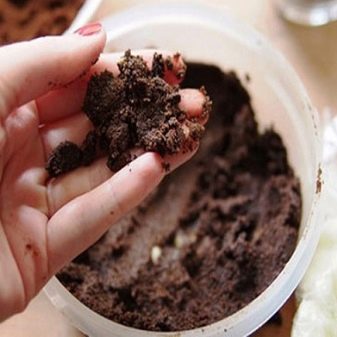
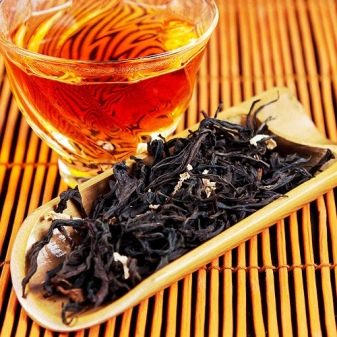
Yeast nutrition promotes the accelerated growth of beautiful flowers. At the same time, it strengthens the root system. The combination of these properties allows the use of yeast to maintain immunity in problem situations. The workpiece is mixed with sugar (in equal proportions), diluted in warm water. It is necessary to withstand it before use for about 3 or 4 hours; in the cold season, yeast feeding is carried out monthly, and in summer - once a decade.
You can also use just sugar.It is enough to mix glucose and water at room temperature. This mixture is used to spray violets from a spray bottle. The intervals between treatments should be exactly 30 days.
But vitamin B12 should be used 2 or 3 times during the growing season, the liquid from ready-to-use ampoules is diluted tenfold with pure water.
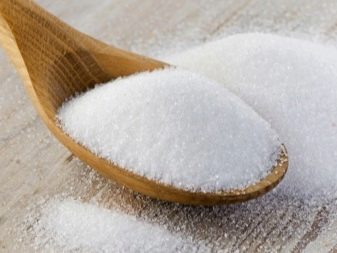
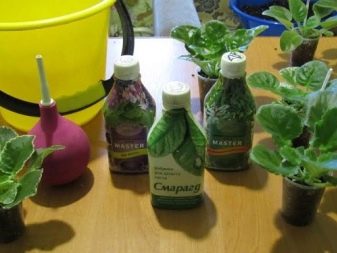
Watering
But even the best fertilizers, added at the right time, and even careful temperature maintenance, will not work without proper irrigation. The external soreness of the violet directly speaks of the lack of moisture. If it is dry, foliage may curl, turn yellow, or dry out. The intensity and mode of irrigation are determined individually for all varieties. In this case, a correction for the air temperature and the state of the plant is also introduced.
Experienced flower growers try, of course, not to bring the matter to the appearance of external signs of flower degradation. Gardeners diligently adhere to precise irrigation schedules. But at the same time, they also check how dry the soil is. Sometimes on the surface it gives the impression of a "scorched desert", while a little deeper under the crust it is very damp.
The check is carried out in the simplest way: sticking a stick.


It should penetrate to the very bottom of the pot. In this case, you should act carefully so as not to break the trunk and not break the roots themselves. It is always taken into account that under intense lighting the substrate can dry out faster than in partial shade. Therefore, when there are violets in the house, placed in unequally lit places, it is necessary to assess the condition of the earth in each pot. It is recommended to pay attention to the total air humidity.
During rapid development, the root system needs a lot of water. However, even "in old age" it is also prone to overdrying. Of course, at the time of active flowering, watering should be increased to the maximum. But the density of the earth allows you to somewhat reduce the consumption of liquid.
Professional gardeners water violets in the morning during the summer months, and during the daytime in November and February.
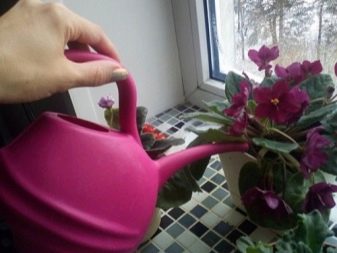
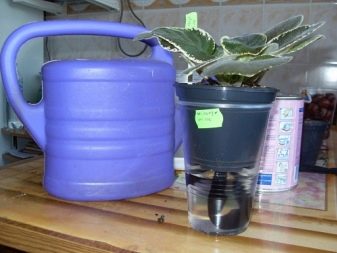
To make the plant bloom more often and look healthier, it is worth experimenting with unconventional watering methods. Wick irrigation is useful if you often have to leave potted flowers unattended. As the employment of people is increasing all the time, the relevance of such a method will also grow. Everything looks very simple: one edge of the wick is lowered into a special container. The opposite edge is inserted into the drainage passage inside the pot.
However, before that, you need to think carefully about everything and take into account the recommendations for:
- wick length;
- his material;
- the volume of the water tank;
- the material from which the container is made.
When winter comes, sump irrigation becomes very valuable. The liquid is poured in even portions, taking into account how it is absorbed. Leave the pot in the pan for 10 or 15 minutes. The excess liquid is discarded.
If left, root rot may begin.
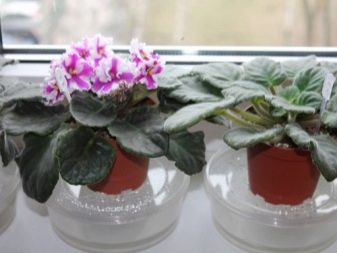
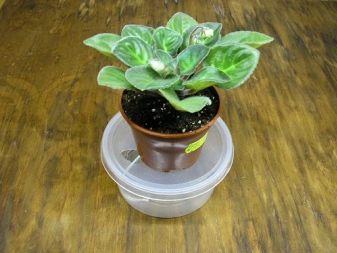
Fight disease
Even when the violet is thoroughly watered and fed, it can undergo various diseases. The situation is even worse if the containment regime is not adhered to. Microscopic fungi, viruses and microbes are also dangerous. A formidable opponent of the grower is powdery mildew (both false and real). Both ailments are provoked by fungi not visible to the eye, only by their different varieties.
Powdery mildew appears at first as a slightly noticeable whitish bloom. It may appear as if a thin layer of wheat flour is scattered over the surface. When the disease worsens, defects appear on all parts of the plant. In the advanced phase, the violet cannot grow at all. Soon she almost inevitably dies, so it's easier not to bring it to this.

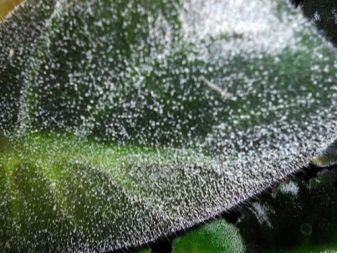
There are a number of recommendations:
- scrupulously observe care measures;
- do not add too much nitrogen to the ground;
- carefully check the soil, do not take it from unknown, unverified sources and places;
- anneal all the earth used for floriculture;
- sterilize all instruments that are used for disembarkation and reproduction.
They fight powdery mildew with fungicides. It is better to focus on time-tested drugs that do not harm delicate foliage. Fluids used for aerosol processing should always be slightly warmer than the air in the room. After cleaning from the fungus with fungicidal preparations, the violet is transferred to the shade. There it is left until all the liquid has evaporated from the leaves.
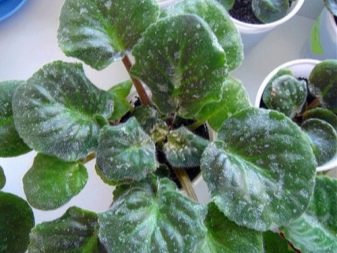
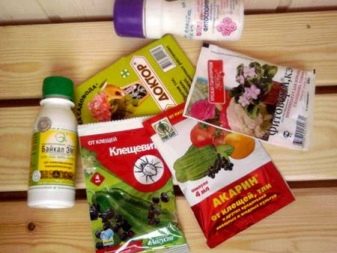
If signs of rust are noticed, you must immediately:
- get rid of infected leaves (best by burning);
- remove the diseased flower from other plants in the room as much as possible;
- carry out the fungicide treatment in accordance with the instructions.
Important! When drug treatments are not working, it is best to accept the loss. The plant won't survive anyway. It is ruthlessly destroyed, and the pot itself must be disposed of. Long inhibition of flowering indicates the defeat of root rot. Also, its characteristic features are the softening of the lower leaves and petioles.
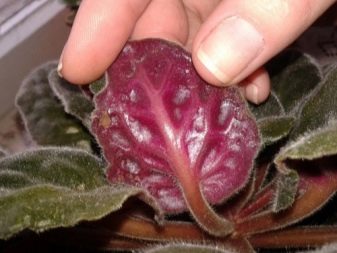
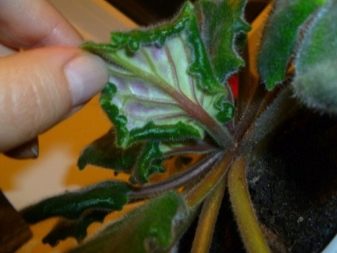
The likelihood of root rot is significantly increased if:
- watering is done without measure;
- there is no drainage channel in the pot;
- the soil is excessively cold;
- the soil was first dried out, and then watered abundantly.
Important! Violets get sick with root rot 3 times more often than all other diseases. In any case, such statistics are given in thematic publications. Experienced flower growers advise to water transplanted and long-standing dry flowers in fractional portions. The interval between waterings is several days.
This continues until the flower regains its original state.

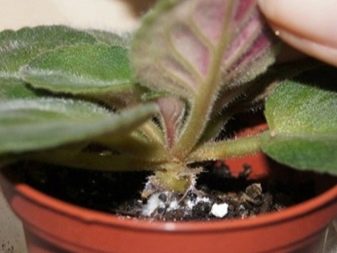
If there is the slightest suspicion of root rot, urgent action is needed. The plant is removed from the pot and the roots are examined. If there are no completely white roots, the worst fears are confirmed. Having found brown spots on the cuts of the stems, you need to cut the stems themselves a little higher. Where there is no rot, the stem is purple inside, and if it is affected by 80% or more, then you will have to get rid of the violet.
Having found a healthy part, it is necessary to remove the leaves from it from below (for the first 1.5 cm). Next, the stem is sprayed with a fungicide. It must be left alone for half an hour, and then transferred to a suitable substance, where new roots will form. The best substrate is wet vermiculite.
It is recommended to cover Saintpaulia with a light-transmitting bag and put in a cool room, illuminated with a lamp of sunlight.
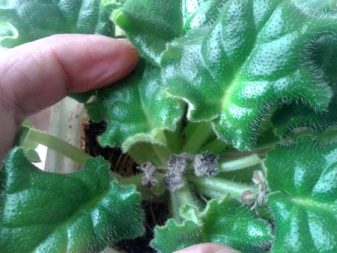
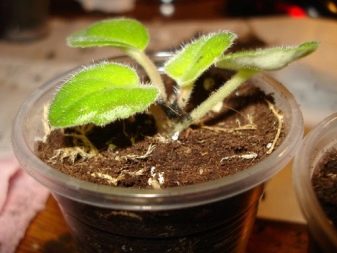
Pruning
Correct pruning allows you to rejuvenate the old violet, thereby avoiding the cost of buying a new flower. Normally, a rosette consists of 3 or 4 rows of foliage. The leaves underneath can look pretty dull. However, it is necessary to improve the appearance of the plant carefully, without thoughtlessly cutting off those leaves, inside which the buds develop. Necessarily needed in case of excessive elongation of the plant:
- cut the pillar to the required size;
- put it in a water tank;
- wait for the formation of roots;
- transplant the violet back into the ground.


How to reproduce?
You can take a shoot and propagate a violet, regardless of the season. But at the same time, you cannot just take land from a vegetable garden or garden. Very often it is too tight. If there is no experience at all, it is worth using store-bought soil. It is pre-selected based on reviews.
More experienced growers prepare potting mixes on their own. They can use various components, but most often there are washed river sand, peat, green and peat mosses, turf from the garden. Perlite is introduced to improve moisture content. Violets are bred (with leaves, seeds, and peduncles) in pots with a diameter of 4 cm.
The main method of obtaining a seedling is by propagation by a leaf in soil or in water.
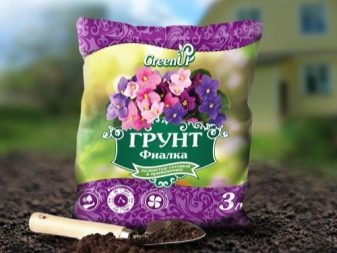
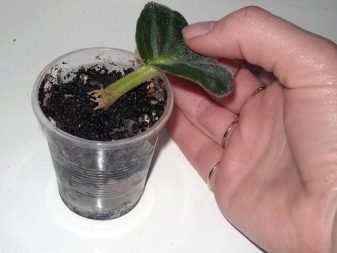
The leaf method involves careful selection of planting material. If it suddenly becomes lethargic, it is simply put in boiled water with the addition of potassium permanganate for 2-3 hours. Next, the sheet is cut 3 or 4 cm above the base. Cutting leaves requires the use of sharp knives or well-sharpened blades. Before this, the cutting part is treated with antiseptic mixtures.
The recommended notch angle is 45 degrees. It is not necessary to withstand it precisely, the assessment is enough by eye. After the cut, at least 3 cm of the stem should remain on the leaves. Then the sheet is washed and dried thoroughly on towels or clean napkins. In about 20 minutes, the release of vegetable juice should stop.
Rooting of leaves in water is most effective inside dark glass containers. You can take medicine bottles, only they must be thoroughly washed. Water is used at room temperature. Activated carbon is added. It takes about 14 days to wait for the roots to appear.
When the sheet suddenly rots, the problem area is cut off, and the workpiece itself is placed in a washed container with fresh water.
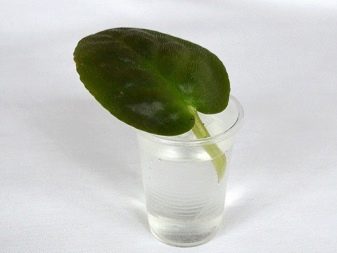
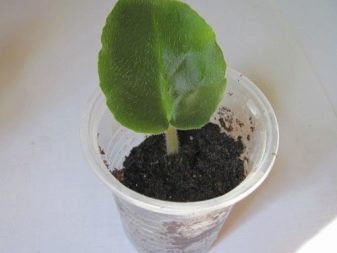
For information on how to water violets in winter, see the video below.































The comment was sent successfully.